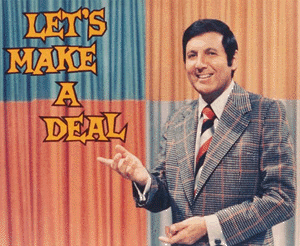Let’s Make a Deal!
A good portion about negotiation is crafting a deal that the other side will want to agree to. It is about building something that works very well for you and well enough for the other side to say “yes.” But we’ve never talked about how to build a good deal.
Until now.
Good deals are ones that:
-Fulfill your interests as best as is possible
-Meet their interests well enough for them to agree to the deal
Got it? Well then let’s negotiate ourselves into a show at a swanky downtown gallery, shall we?
Pamela Percent runs You Know You Want To Gallery in the Pearl. You Know You Want To is well known and respected in the arts community and gets fairly good foot traffic, both on First Thursday and throughout the rest of the month. In the past the gallery has had a good sales record, though the last few months have been slow. Pamela is known as a tough negotiator and that has served her gallery and the artists who show there very well.
Pamela is putting together a show of up-and-coming Portland artists and has approached you about participating. She’s told you that she intends for it to be a six artist show and she currently has four artists lined up. You know that she also approached your friend, Jason Bourne, but he ended up turning her down because he thought the commission she was demanding was too high.
The show allows four to five pieces per artist, but Pamela is asking you to submit only three pieces. There is a large multi-media piece of yours in progress that she saw last week and very much wants for one of the main walls of the show. Because the piece, “Gigantor,” is so large, she feels that it wouldn’t be fair to the other artists if you were allowed three additional pieces.
You were planning on finishing “Gigantor” sometime in the next two months; you figure it needs about a month of work at a comfortable pace, but could be finished in 3 weeks if you dropped all other projects and worked weekends. The show is in three and a half weeks. Pamela said that you can still participate in the show if you don’t submit “Gigantor,” but that you won’t get as much visibility in the show if you don’t.
If you can negotiate reasonable terms with Pamela, this will be your highest profile show to date.
Take out a piece of paper or open a file. Divide the paper in half and on the top of one half write “Me” and on the other “Pamela.”
Now spend five minutes and write out all of the interests you have in this show and all of the interests that Pamela has. Pretty much anything you think you see as an interest is fair game.
The point of writing the interests out like this is so you can see them side by side. A lot of times in negotiations it is difficult to see where interests are shared just because we don’t look at our interests and the other side’s interests at the same time or in the same place.
So what are your interests?
- Being in the show sounds like it’d be great for your reputation.
- Having art for sale in Pamela’s gallery may get you a better sale price because of her negotiating skills.
- You’d rather not have to give up the other projects you’re working on.
- Having the visibility that she promising with “Gigantor” would be great.
- Having a good relationship with Pamela will be helpful if you decide to stay in Portland.
What about Pamela’s interests?
- She needs at least one more artist from the “up and coming” set.
- She wants “Gigantor” in her gallery and if she wants it on the main wall, she probably doesn’t have another large compelling piece lined up.
- Sales have been slow, so she needs a show that will get attention and art that will sell.
- She’s short on time if the show is three and a half weeks away and she’s still filling out space.
(You likely have even more interests written out on your sheet; if I didn’t mention something you wrote out, you’re not wrong. I’m just condensing for space.)
You have a pretty great BATNA in this situation: she’ll let you be in the show even if the piece she wants isn’t available. All deals that are better than your BATNA are worth negotiating for.
You know that her BATNA isn’t great but it’s also not bad: she gets you, but not “Gigantor,” and needs to find one more artists for the show.
A deal she’s say “yes” to needs to be better than her BATNA.
Step one: Call Jason. Why did he really turn her down? What was the percentage she was asking? Could he be convinced to participate in the show or does he have a heard conflict with the timing or a prior commitment?
If you can get Jason to join the show, you can pitch a deal that gives you real leverage, but even if you can’t, knowing about how Pamela negotiated with someone else is very helpful.
Step two: Figure out how much it would cost you — lost opportunity, materials, real dollars — to finish “Gigantor” on Pamela’s schedule. Figure out if you want to finish “Gigantor” on Pamela’s schedule.
Step three: Call the other artists that are participating; ask what kind of pieces they’re contributing and, if they’ll tell you, the agreed upon terms they hashed out with Pamela.
Step four: based on what you learn from the other artists, look at your finished pieces and decide what you think would be most successful at the show. You can define “success” any way you like — attention, money, controversy — but at least half of the six to seven pieces you pick out should be pieces you think will sell.
Let’s assume everyone told you the percentage Pamela took for commission in their contracts, that Jason is willing to do the show if Pamela budges on her commission a bit and you are willing to work to finish “Gigantor.”
The Deal
Call Pamela and tell her you think you can get “Gigantor” done in time if she’s willing to negotiate a few terms. In the same phone call inform her that you think Jason would be willing to do the show and ask if she’s interested. If she is, let her know that Jason just needs a bit of flexibility in her rate and offer to tell him to call her. Set up a meeting with Pamela to talk about “Gigantor.”
At the meeting explain what you’ll need to do to finish “Gigantor” and make sure Pamela is aware of all the costs you figured out. Tell her that you believe with a few tweaks to her offer you can make it work.
— Because you’ll be limited in the number of pieces you submit, you’d like a lower commission rate on any sales of the three non-”Gigantor” pieces. To make the lower rate more palatable, you’ll let her pick which three pieces are in the show from the six or seven you’ve identified. By letting her pick, she can identify which pieces she thinks will be most likely to sell.
— If you cannot finish “Gigantor” by a certain agreed upon point in time, she’ll let you submit three pieces in its place at her regular commission rate. By allowing you three additional pieces you can help to fill any space left by the absence of “Gigantor.”
Why present the deal in this particular manner?
Jason provides great leverage but you don’t want to end up acting as his de facto agent and being responsible for how he behaves with Pamela. You want to show her you are helpful and can serve as a connector, not take on additional responsibility. By offering this re-connection up before you get into brass tacks on your contract, you show her good will and your awareness of her interests.
“Gigantor” is something she wants. Don’t just give her something she wants without making it beneficial for yourself in some way. Negotiating a separate, better rate for non-Gigantor pieces helps to address the fact that you get fewer pieces in the show.
Letting her pick the remaining pieces gives her some ownership in those selections and can soften the blow of a smaller commission. A sale she thinks is likely with a lower commission is better than a 50/50 chance at her normal rate.
Finally, you offer up an agreed upon “In Case of Emergency” plan that is still beneficial to both of you. By agreeing on what happens if things don’t go exactly as planned, you can set expectations and avoid potential conflicts.
Congratulations! You made a deal!
Now could you make another deal out of this same set of fact? Of course! Could it be even better than the one I’ve made? Absolutely. A single problem can create a great number of solutions and the best people to determine if it is a good or bad deal are the ones who will have to live with it.
The best way of going about making a deal, though, is to look at what both sides are interested in, understand what the alternatives are, and find the places where interests overlap and agreement is most likely. Break it down into those basic tasks and anyone can make a deal.
Categories: Negotiation Strategy




[…] Source: http://www.workmadeforhire.net/negotiation-strategy/lets-make-a-deal/ […]